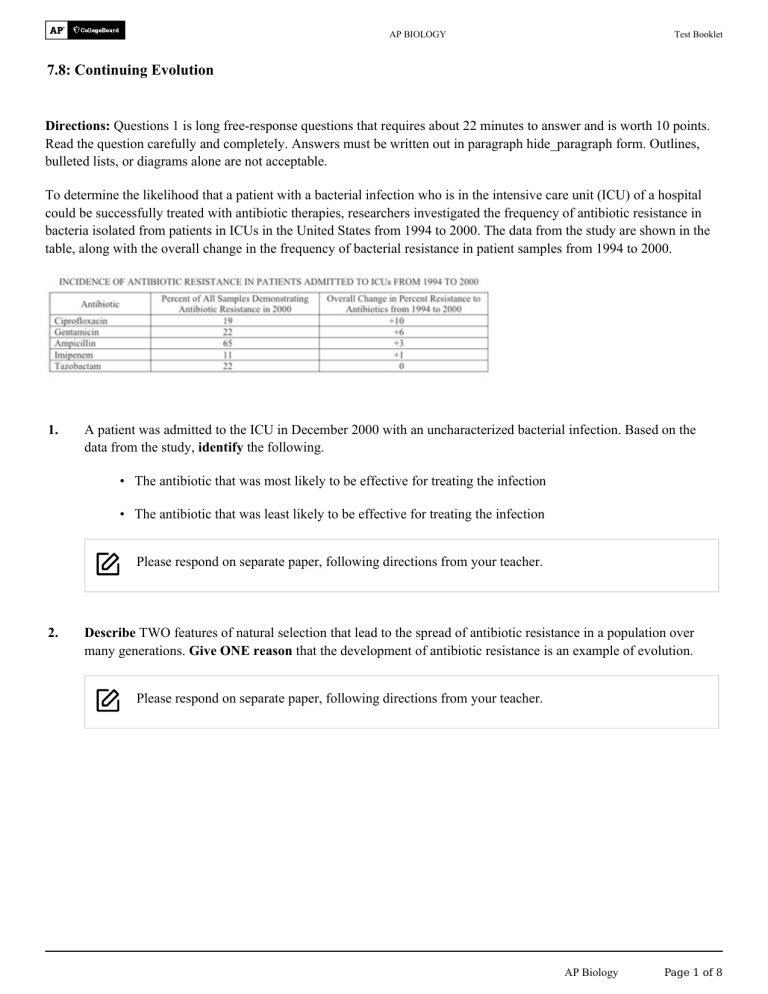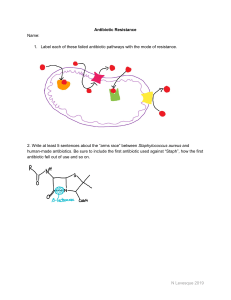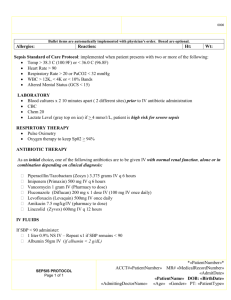
AP BIOLOGY Test Booklet 7.8: Continuing Evolution Directions: Questions 1 is long free-response questions that requires about 22 minutes to answer and is worth 10 points. Read the question carefully and completely. Answers must be written out in paragraph hide_paragraph form. Outlines, bulleted lists, or diagrams alone are not acceptable. To determine the likelihood that a patient with a bacterial infection who is in the intensive care unit (ICU) of a hospital could be successfully treated with antibiotic therapies, researchers investigated the frequency of antibiotic resistance in bacteria isolated from patients in ICUs in the United States from 1994 to 2000. The data from the study are shown in the table, along with the overall change in the frequency of bacterial resistance in patient samples from 1994 to 2000. 1. A patient was admitted to the ICU in December 2000 with an uncharacterized bacterial infection. Based on the data from the study, identify the following. • The antibiotic that was most likely to be effective for treating the infection • The antibiotic that was least likely to be effective for treating the infection Please respond on separate paper, following directions from your teacher. 2. Describe TWO features of natural selection that lead to the spread of antibiotic resistance in a population over many generations. Give ONE reason that the development of antibiotic resistance is an example of evolution. Please respond on separate paper, following directions from your teacher. AP Biology Page 1 of 8 Test Booklet 7.8: Continuing Evolution 3. (c) The researchers also found that after 150 days, the relative change in virulence of B. thuringiensis was greater than the relative change in the resistance in C. elegans when the organisms were cultured together. Provide ONE reason that the relative change in B. thuringiensis virulence was greater than the relative change in C. elegans resistance. Please respond on separate paper, following directions from your teacher. (b) The researchers found that after 150 days, the magnitude of the change in both B. thuringiensis virulence and C. elegans resistance was less when they were cultured individually (control) than when they were cultured together (experimental). Provide ONE reason for the difference in results between the two treatments. Please respond on separate paper, following directions from your teacher. Caenorhabditis elegans is a species of soil-dwelling nematode (roundworm) that feeds on soil bacteria, including Bacillus thuringiensis. B. thuringiensis is a virulent bacterial pathogen that produces BT toxin, a protein that can kill different invertebrate species, including C. elegans. In a laboratory experiment, C. elegans and B. thuringiensis were cultured individually (control) or together (experimental) for 150 days. Under optimal conditions, the generation time of C. elegans is approximately 3.5 days and the generation time of B. thuringiensis is approximately 25 minutes. At the end of the experiment, the change in virulence of B. thuringiensis and the change in resistance of C. elegans to BT toxin were determined. (a) Calculate the maximum number of generations that is possible in individual cultures of C. elegans AND the maximum number of generations that is possible in individual cultures of B. thuringiensis in 150 days. Please respond on separate paper, following directions from your teacher. Caenorhabditis elegans is a species of soil-dwelling nematode (roundworm) that feeds on soil bacteria, including Bacillus thuringiensis. B. thuringiensis is a virulent bacterial pathogen that produces BT toxin, a protein that can kill different invertebrate species, including C. elegans. In a laboratory experiment, C. elegans and B. thuringiensis were cultured individually (control) or together (experimental) for 150 days. Under optimal conditions, the generation time of C. elegans is approximately 3.5 days and the generation time of B. thuringiensis is approximately 25 minutes. At the end of the experiment, the change in virulence of B. thuringiensis and the change in resistance of C. elegans to BT toxin were determined. Page 2 of 8 AP Biology Test Booklet 7.8: Continuing Evolution 4. Calculate the maximum number of generations that is possible in individual cultures of C. elegans AND the maximum number of generations that is possible in individual cultures of B. thuringiensis in 150 days. Please respond on separate paper, following directions from your teacher. 5. The researchers found that after 150 days, the magnitude of the change in both B. thuringiensis virulence and C. elegans resistance was less when they were cultured individually (control) than when they were cultured together (experimental). Provide ONE reason for the difference in results between the two treatments. Please respond on separate paper, following directions from your teacher. 6. The researchers also found that after 150 days, the relative change in virulence of B. thuringiensis was greater than the relative change in the resistance in C. elegans when the organisms were cultured together. Provide ONE reason that the relative change in B. thuringiensis virulence was greater than the relative change in C. elegans resistance. Please respond on separate paper, following directions from your teacher. 7. Researchers examined the ability of cultures of the bacterium Pseudomonas aeruginosa to adapt to the antibiotics ceftazidime and avibactam when they are administered together. The researchers grew four replicate cultures in growth medium with no antibiotics added (control) and four additional replicate cultures in the same growth medium with added ceftazidime and avibactam. At the conclusion of the experiment, samples of the replicates exposed to the antibiotics were removed and their genomes were sequenced. All of the antibiotic-resistant mutants were missing three genes ( , , ). It is known that one of these three genes makes wild-type P. aeruginosa susceptible to the two antibiotics. However, the researchers do not know which gene it is. Which of the following experiments would specifically determine which gene is responsible for ceftazidimeavibactam sensitivity in P. aeruginosa ? (A) Clone the three deleted genes from a wild-type P. aeruginosa strain, and insert these sequences into the mutant bacterial strains to restore sensitivity to ceftazidime-avibactam. (B) Delete genes that are homologous to the three deleted genes in other bacterial species, and determine if doing so also confers ceftazidime-avibactam resistance in those bacteria. (C) , , or gene on separate Perform gene knockout (targeted mutation) of either the cultures of the wild-type P. aeruginosa. For each individual mutant, determine whether or not ceftazidimeavibactam resistance has occurred. Perform gene knockout (targeted mutation) of both the and genes of the wild-type P. (D) aeruginosa in a single culture, and then determine if ceftazidime-avibactam resistance has occurred in the mutant strain. AP Biology Page 3 of 8 Test Booklet 7.8: Continuing Evolution 8. Low doses of antibiotics are often added to livestock feed to increase production. Studies have shown that bacterial populations constantly exposed to the sublethal doses can evolve resistance to the antibiotics. A research group claimed that when a population of bacteria are constantly exposed to sublethal doses of streptomycin, their fitness declines due to the increased energy requirements for survival in the presence of the antibiotic. For subsequent studies, the researchers wish to determine whether adding a low, sublethal dose of an additional antibiotic causes further decline in the fitness of the bacteria. Which of the following best represents the next step the researchers should take with respect to experimental design? 9. (A) Group 1: high dose of streptomycin Group 2: low dose of streptomycin low dose of additional antibiotic high dose of additional antibiotic (B) Group 1: low dose of streptomycin Group 2: low dose of streptomycin no dose of additional antibiotic low dose of additional antibiotic (C) Group 1: no dose of streptomycin no dose of additional antibiotic Group 2: low dose of streptomycin low dose of additional antibiotic (D) Group 1: low dose of streptomycin Group 2: high dose of streptomycin low dose of additional antibiotic high dose of additional antibiotic MRSA is the acronym for methicillin-resistant Staphylococcus aureus. Many of the strains of the common bacterium are also resistant to other antibiotics in use today. The resistance is linked to a collection of genes carried on plasmids that are passed from one bacterium to another by conjugation. Suppose a newly discovered, chemically different antibiotic is used in place of methicillin. Which of the following would be the most likely effect on Staphylococcus aureus antibiotic resistance? (A) The gene for methicillin resistance, no longer needed, would disappear entirely from Staphylococcus aureus populations within a few generations. (B) Transmission of the methicillin-resistance plasmid by conjugation would increase among the Staphylococcus aureus population as the genes would confer resistance to the new antibiotic. (C) Transmission of the methicillin-resistance plasmid would gradually decrease but the plasmid would not entirely disappear from the Staphylococcus aureus population. (D) Transmission of the methicillin-resistance plasmid by conjugation would increase among the Staphylococcus aureus population due to destruction of bacteria without the plasmid through use of the new antibiotic. Page 4 of 8 AP Biology Test Booklet 7.8: Continuing Evolution 10. Read each question carefully. Write your response in the space provided for each part of each question. Answers must be written out in paragraph form. Outlines, bulleted lists, or diagrams alone are not acceptable and will not be scored. River dolphins are morphologically distinct from other dolphins and are primarily restricted to freshwater ecosystems in Asia and South America. Determining the phylogeny of these animals based on morphology has been difficult because they have a large number of derived characters including a long, narrow rostrum (beak), a low dorsal fin, a flexible neck, and eyes that are greatly reduced. River dolphins were originally classified together based on morphology, but molecular studies have shown that they are less closely related than previously thought. Scientists analyzed the nucleotide sequences of mitochondrial genes, including the genes for cytochrome b and two ribosomal . By combining the nucleotide sequence data with analyses of embryonic development and morphology, the scientists have proposed the phylogenetic tree shown in Figure 1. Baleen whales that are filter feeders are used as an outgroup. Figure 1. Phylogenetic tree of the cetaceans, including the toothed whales and baleen whales (a) Based on the phylogenetic tree, identify approximately how many millions of years ago the earliest South Asian river dolphin evolved. Round your answer to the nearest whole number. Please respond on separate paper, following directions from your teacher. (b) Using the template of the phylogenetic tree, circle the lineages that share node A. AP Biology Page 5 of 8 Test Booklet 7.8: Continuing Evolution Template for part (b) Please respond on separate paper, following directions from your teacher. (c) Based on the sequence analyses of the three mitochondrial genes, scientists hypothesize that the La Plata river dolphin is more closely related to the Amazon river dolphin than to the Chinese river dolphin. Evaluate this hypothesis by describing the sequence data that would support this hypothesis. Please respond on separate paper, following directions from your teacher. (d) Molecular data indicate that river dolphins do not form a monophyletic group. Explain why these animals nevertheless have morphological similarities. Please respond on separate paper, following directions from your teacher. Page 6 of 8 AP Biology Test Booklet 7.8: Continuing Evolution Staphylococcus aureus is a pathogenic bacterium that can infect a wide range of host species, including humans. S. aureus has a particular protein that binds with hemoglobin from the host organism. Hemoglobin is the iron-containing protein used to transport oxygen in the blood. Since iron is important for growth, S. aureus have evolved the ability to absorb the iron from the host's hemoglobin. Different S. aureus strains preferentially infect different hosts and have different amino acid sequences at their hemoglobin-binding domains (Table 1; letters indicate different amino acids). In an experiment, different S. aureus strains were mixed with hemoglobin from macaque monkeys and their binding ability was measured (Figure 1). The differences in amino acid sequences contributed to the differential binding abilities observed. Table 1. Selected amino acid sequences and preferred host for four strains of S. aureus S. aureus Strain Amino Acid Sequence Host Species 1 QQFYHYARS Species A 2 RQAYHYART Species B 3 QQAYHYART Macaque 4 RQAAHYQLT Species C AP Biology Page 7 of 8 Test Booklet 7.8: Continuing Evolution Figure 1. Macaque hemoglobin binding ability of different strains of S. aureus 11. Which of the following experiments would be most appropriate to determine whether populations of S. aureus are continuously adapting in order to obtain iron from hosts more effectively? (A) Grow S. aureus in media with macaque hemoglobin and abundant free iron. Record bacterial growth over time and compare it to growth of the original population. (B) Culture S. aureus bacteria with hemoglobin from a mixture of host species. Then transfer the bacteria to media with a known effective antibiotic and record bacterial growth. (C) Sequence the genes of different S. aureus strains and construct a cladogram representing their relatedness. Culture S. aureus bacteria with hemoglobin from a novel host species as the only source of iron for many (D) generations, then compare protein structure from bacteria in this culture with bacteria from the original culture. Page 8 of 8 AP Biology




